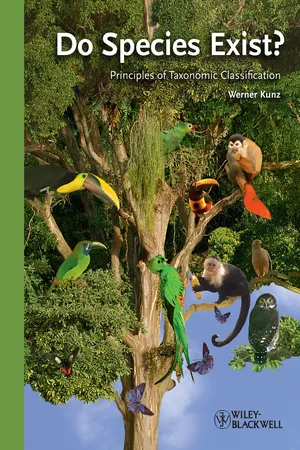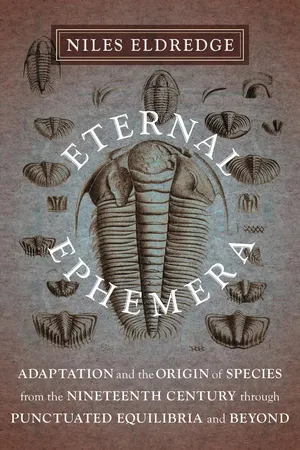Biological Sciences
Allopatric Speciation
Allopatric speciation is the process by which new species evolve from a common ancestor due to geographic isolation. It occurs when a population is divided by a physical barrier, such as a river or mountain range, preventing gene flow between the separated groups. Over time, genetic differences accumulate, leading to the formation of distinct species.
Written by Perlego with AI-assistance
Related key terms
5 Key excerpts on "Allopatric Speciation"
- eBook - ePub
Do Species Exist?
Principles of Taxonomic Classification
- Werner Kunz(Author)
- 2013(Publication Date)
- Wiley-Blackwell(Publisher)
In the case of certain Weevil beetles or nematode worms, however, allopatric conditions can also be produced by a lifelong confinement in the interior of a host plant that prevents a mutual encounter with each other, even in the same geographic position (McCoy, 2003). These animals spend their entire life cycles on or even in the interior of a single food plant without ever leaving the host plant. These examples have an external cause for separation that has nothing to do with a geographic separation. This form of separation is also an allopatry, although not through a geographical barrier. In every case of allopatry, however, the absence of crossbreeding is not based on the properties of the organisms themselves but, instead, is based on external barriers. Thus, the organisms themselves then carry no properties of separation at all within them. Their separation is not based on speciation genes. Those genes can, at best, evolve by pure chance.Sympatric and allopatric separations are two entirely different evolutionary ways for speciation, and the question arises as to whether both types of group separation should receive the same name and whether both should be called species:1. sympatric speciation is the origin of separated groups that are in competition and are separated by a control of selection at the same location, while2. Allopatric Speciation is the formation of species by chance due to genetic drift at locations that are isolated from each other.Sympatric speciation can occur if the sexual partners evolve new preferences for partner recognition. Females with newly evolved demands for specific traits in their male partners and the respective males, which conform to these demands, can split off as a distinct species and can separate from the rest of the members of the original species. This scenario is sympatric speciation resulting from sexual preference.An additional possibility for sympatric speciation is the segregation of a few organisms into a new ecological niche, which opens up new resources and, thus, signifies an advantageous adaptation, for example, if a group of a monophagous beetle species switches to a new food plant and becomes adapted to this new food plant. For this separation to become stable, a corresponding selective partner choice must coevolve at the same time. Only under this condition, the conquest of the new ecological niche is not reversed again by backcrossing with the organisms that still have a preference for the former food plant. If, therefore, a few individuals within species A conquer a new food plant and rely on this new plant in the future, then they can only turn into the new species B if, simultaneously, an assortative mating is guaranteed that makes certain that B -organisms from now on mate only with B -organisms and not with A - eBook - ePub
- Michael Heads(Author)
- 2016(Publication Date)
- CRC Press(Publisher)
Biological groups, especially close relatives, are often allopatric; that is, they occupy different areas. Allopatric groups may be separated by a gap (they are “disjunct”), but their distributions often meet without any obvious physical barrier between them. In other groups, the distributions overlap—they show varying degrees of sympatry. Biogeography needs to explain both allopatry and sympatry, but allopatry is a distinctive, fundamental phenomenon seen in most groups, and many authors have accepted its primary significance in evolution. Among the New Zealand gentians, for example, “allopatry is much more frequent than sympatry” (Glenny, 2004).Species ConceptsThe concept of species is controversial, and the particular concept that is used in a biological analysis is often regarded as critical. This book uses the species concept outlined by Darwin (1859: 32): “I look at the term species, as one arbitrarily given for the sake of convenience to a set of individuals closely resembling each other, and that it does not essentially differ from the term variety.” This is very different from the neodarwinian concept, in which species have a fundamental importance. In Darwin’s model, species are not regarded as special compared with groups at other ranks, above or below the species level (Heads, 2014). As Dennett (1996: 95) wrote, discussing the definition of species: “Where should we draw the line? Darwin shows that we don’t need to draw the line in an essentialist way to get on with our science… I am inclined to interpret the persisting debates [about species definitions] as more a matter of Aristotelan tidiness than a useful disciplinary trait.” Dobzhansky (1937: 312) argued in a similar vein: “Species is a stage in a process, not a static unit.” (In contrast, the neodarwinian view stressed that “a species is not a stage of a process, but the result of a process” [Mayr, 1942: 119].) - eBook - ePub
A New Approach to Conservation
The Importance of the Individual through Wildlife Rehabilitation
- Gill Aitken(Author)
- 2018(Publication Date)
- Routledge(Publisher)
There are differences, for example, in the degree of isolating change necessary for the formation of a new species. Wilson (1992) tells of the very small segregation between species of leafroller moths in the family Tortricidae. He says that '[t]he variation they manifest from one species to the next is the kind commonly based on mutations in only one gene' (p. 65). Variation might even be more elementary still, for some leafroller species are separated by:a difference not in the organic structure of the substances composing the sex attractants but in the percentages of the substances, in this case a variety of acetates, that go into the blend.Once species are reproductively isolated, the genetic distance between them begins to widen. So the category of 'species' covers variety in the degree of isolating change that was necessary for their formation, as well as differences in genetic distance from parent species depending upon the length of time since speciation took place.There are also differences in the nature of the isolating mechanisms. Some speciation is allopatric (in a different place) while other speciation is sympatric (in the same place). In the latter case, speciation may be through polyploidy (an increase in the number of chromosomes) or non-polyploid sympatric speciation such as 'through the intermediate host races of insects that feed on plants' (Wilson, p. 66). Sympatric speciation is to be widely found in the plant kingdom but in the animal kingdom it is mainly restricted to insects. The fact that sympatric speciation takes place on so small a stage means that when speciation takes place, the new species are genetically much closer to the parent species than is the case in Allopatric Speciation.Finally, there are also significant differences in the time required for the formation of new species. At one end of the spectrum is Allopatric Speciation while at the other end is sympatric speciation. The former kind of speciation may take a very long time (many generations) whereas polyploid speciation 'is virtually instantaneous in its effect, potentially isolating a group of individuals from its ancestors in one generation' (p. 63). - eBook - ePub
Eternal Ephemera
Adaptation and the Origin of Species from the Nineteenth Century Through Punctuated Equilibria and Beyond
- Niles Eldredge(Author)
- 2015(Publication Date)
- Columbia University Press(Publisher)
This, unbeknownst to me, is very close to one of Darwin’s two visions on how a law of adaptation would act, as developed in Notebook B (1837).the gradualistic view is at odds with accepted views of speciation derived from studies of the modern biota. And though undoubtedly phyletic transformation has no doubt led to the appearance of descendent taxa reasonably construed as new, descendant species [a view I have long since completely abandoned], nevertheless a model that allows for one or multiple speciation events during the same period of time would be the more satisfactory for the explanation of the diversity of life since the Cambrian. On probabilistic grounds alone, we must conclude that the overwhelming majority of metazoan species that have appeared on earth’s surface arose through some process of splitting. (156).I then discuss the preference among most biologists for the allopatric (geographic) model of speciation, in which a period of geographic isolation between conspecific populations is generally deemed necessary (though not in all cases wholly sufficient) for reproductive isolation to be established, and for new species to evolve. And I then “suggest that the allopatric model (geographic speciation) be substituted in the minds of paleontologists for phyletic transformism as the dominant mechanism of the origin of new species in the fossil record, and that the allopatric model, rather than gradual morphological divergence, is the more correct view of the processes underlying cases of splitting already documented by numerous workers” (1971a:156–157).After a brief discussion of environments of the Paleozoic shallow-water epicontinental (“cratonal”) seas, I then present a four-alternative description and analysis of the dominant evolutionary theories that have been routinely applied to explain the succession of non-intergrading, yet closely similar, and arguably ancestral/descendant species in the fossil record (figure 5.3 - eBook - ePub
- David Baum, Douglas Futuyma, Hopi Hoekstra, Richard Lenski, Allen Moore, Cahterine Peichel, Dolph Schluter, Michael Whitlock(Authors)
- 2013(Publication Date)
- Princeton University Press(Publisher)
If populations are separated long enough, the genomes of those populations can diverge to the point at which they remain distinct even if they come into secondary contact in the future. Under allopatric conditions, alleles contributing to reproductive isolation can spread through neutral genetic drift, sexual selection, and natural selection. Directional selection is likely the major form of selection that drives the evolution of reproductive isolating barriers between allopatric populations. Alleles under natural selection or genetically linked to genes under natural selection tend to have a higher substitution rate 4 Ns μ (for which N is the population size, s is the coefficient of selection, and μ is the per generation per gene mutation rate) than neutrally evolving genes, for which the substitution rate is simply μ. Thus, adaptive mutations can be substituted at a faster rate than neutral mutations. When diverging populations experience migration, successful differentiation is dependent on the strength of selection and the rate of gene flow between those populations. Migration between populations resulting in gene flow allows recombination to homogenize differences. It is therefore unlikely that uniform directional selection could result in the evolution of reproductive isolation between populations that exchange genetic material, because any universally adaptive mutation arising in one population would quickly be spread through all populations that exchange migrants. In contrast, divergent directional selection across habitats can result in reproductive isolation between populations even in the face of considerable migration. If selection is strong enough, regions of the genome that are involved in adaptations to different habitats will remain divergent
Learn about this page
Index pages curate the most relevant extracts from our library of academic textbooks. They’ve been created using an in-house natural language model (NLM), each adding context and meaning to key research topics.




